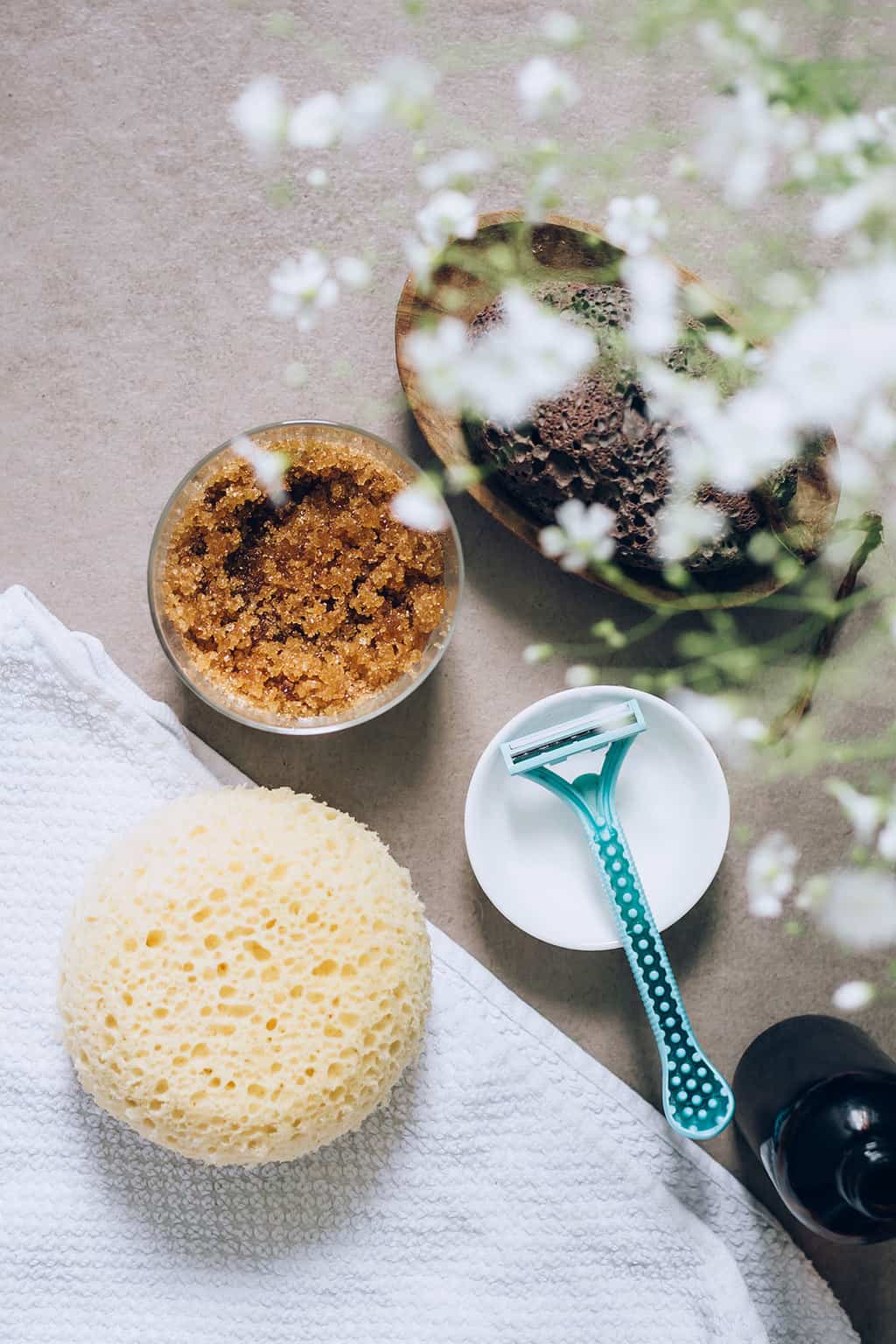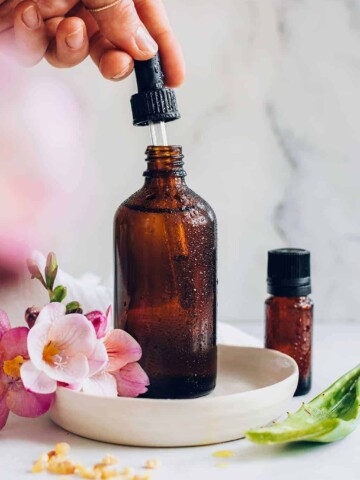The star of my new skincare regimen is this homemade aloe vera face wash that removes daytime makeup and grime without stripping my skin of moisture. In addition to the superstar aloe vera plant, this cleanser uses rose water, Castile soap, and essential oils to keep your skin looking radiant.

I don’t care what the experts say; attaining flawless skin isn’t as easy as washing your makeup brushes and changing out your pillowcase every couple of days. Just like when I was a teenager, my “more mature” skin isn’t afraid to tell me when I’ve done something it doesn’t like—which, apparently, is all too often.
I overhauled my skincare routine to figure out the cause of my annoying breakouts. Turns out I needed a homemade cleanser that removed daytime makeup and grime without stripping my skin of moisture or adding to the irritation—and this aloe cleanser worked like a charm.
Jump to:
Benefits of Aloe Vera for Skin

Aloe vera is a powerhouse when it comes to skincare. Known for its anti-inflammatory, antibacterial, and wound-healing properties [source], it’s packed with antioxidants, enzymes, and vitamins A, C, and E [source].
Aloe vera is often used to treat sunburns, psoriasis, and eczema [source]. Beyond external applications, drinking drinking aloe water, smoothies, or other aloe drinks can provide many internal benefits as well [source]!
Why Aloe Vera Is Great for Your Skin
Whether your skin is problematic or you just want to keep it looking healthy, aloe vera can help:
- Exfoliate Dry Skin: Makes your skin appear smoother and softer.
- Soothe Inflammation: Reduces irritation caused by bacteria.
- Reduce Acne and Scars: Helps minimize the appearance of acne, scars, and wrinkles.
- Improve Moisture Content: Keeps your skin hydrated.
Because of these benefits, I’ve added a generous amount of aloe vera gel to my homemade face wash to soothe the skin, balance the microbiome, and keep inflammation at bay—leaving you with some seriously radiant skin.
How To Use Fresh Aloe

To get the biggest bang for your buck, I like to use fresh aloe vera gel in my face wash. Because it’s straight from the source, the vitamins and nutrients in the gel are the most potent.
Here's how to harvest it:
- Choose a Mature Aloe Plant: Select a plant that is at least a few years old for the best gel.
- Cut a Leaf: Use a sharp knife to cut a thick, healthy leaf from the base of the plant.
- Drain the Resin: Let the yellow resin (aloin) drain out by standing the cut leaf upright in a container for about 10-15 minutes. This resin can be irritating to the skin.
- Extract the Gel: Lay the leaf flat and slice off the spiky edges. Carefully peel away the skin on one side and scoop out the gel with a spoon.
- Puree the Gel: Blend the extracted gel in a food processor to achieve a smooth consistency.
- Storage: Store the fresh aloe gel in an airtight container in the refrigerator and use it within a few days.
Face Wash Ingredients

In addition to aloe vera, this face wash also uses more hydrating and cleansing ingredients to keep your skin glowing.
- Rose Water: Balances skin pH, fights inflammation [source], and reduces oil production. Its antioxidant and anti-inflammatory properties help soothe redness and irritation.
- Castile Soap: A gentle cleanser that clarifies skin without stripping natural oils. I use Dr. Bronner’s Baby Castile Soap for my face because it’s made especially for sensitive skin and contains no added essential oils.
- Chamomile Essential Oil: Known for its calming properties, it reduces inflammation and soothes the skin.
- Avocado Oil: Moisturizes and nourishes the skin. You can substitute it with any other oil you prefer.
Aloe Face Wash Recipe
- ½ cup aloe vera gel (if using fresh, harvest the gel and puree in a food processor ahead of time)
- ½ cup rose water (add more or less depending on your preferred consistency)
- 2 tablespoons Castile soap
- 6-9 drops chamomile essential oil
- 2 teaspoons avocado oil
- 8-ounce pump bottle or squeeze bottle
Instructions
Using a small funnel, combine all ingredients in a bottle. Screw the lid on tightly and shake well to combine.
Using Aloe Face Wash

Use this face wash once or twice daily, depending on your skin type and needs. If you have very dry or sensitive skin, you might want to limit use to once a day.
Rub a dime-sized amount between your hands and gently massage into your skin, avoiding the eye area. Rinse completely with lukewarm water.
This face wash can help remove makeup. However, for heavy or waterproof makeup, you might want to use a dedicated makeup remover first and then follow with the aloe vera face wash.
Hint: Shake the bottle well before each use to mix the ingredients back together. It’s normal for homemade products to separate over time.
Substitutions
Store-bought aloe gel: You can also get similar benefits with store-bought gel, assuming you use the right kind. Skip the chemical-laden stuff found at the drug store and instead opt for pure aloe vera gel, like this Lily of the Desert 99% Aloe Vera Gelly (my all-time fave).
Essential oils: You can customize your face wash with other essential oils depending on your skin type and preferences. For example, lavender oil is great for soothing, tea tree oil for acne-prone skin, and frankincense for anti-aging benefits.
Carrier oil: Swap out avocado oil for a carrier oil that works for your skin type. I like rosehip seed oil because it's rich in vitamins and antioxidants, fights free radicals, and promotes smoother skin.
Customization Tips
- For Dry Skin: Add extra avocado oil or another moisturizing oil to your cleanser recipe.
- For Oily Skin: Consider adding a few drops of tea tree oil for its acne-fighting properties.
- For Sensitive Skin: Ensure all ingredients are free from additives and preservatives that might irritate your skin.
- For Exfoliation: You can add gentle exfoliants like ground oats, almond meal, or sugar to create an exfoliating face wash. However, use these ingredients sparingly to avoid over-exfoliating your skin.
Preservation and Storage
- Fresh Aloe Gel: Store the face wash in the refrigerator and use it within 7 days.
- Commercial Aloe Gel: Opt for pure aloe vera gel without chemical additives. This version can last 2–3 weeks without refrigeration.
- To make the recipe last longer add a preservative made specifically for water-based products.
FAQ
You can use store-bought aloe vera gel. Look for products that are 99% pure aloe vera gel with no added chemicals or preservatives.
Sure! Give it a try and see how you like it. If you find that this combo is drying, try adding a bit of tap water to thin it out a bit.
To make the face wash more hydrating, you can add more oil to the recipe or a few drops of hyaluronic acid serum or glycerin, which are known for their moisture-retaining properties. And always apply oil, serum, or moisturizer after using your cleanser.
Aloe vera is especially good at soothing inflammation and healing wounds. If you'd like a little more acne-fighting power, try adding honey or tea tree oil.
You can make a larger batch, but keep in mind that if you’re using fresh aloe vera gel, it will need to be refrigerated and used within a few days. If you use commercial aloe vera gel with preservatives, it can last longer (about 2–3 weeks).
More Ways To Use Aloe Vera
Want to try more ways to use aloe vera gel? Here are some of our readers' favorite recipes:
Aloe Vera Face Wash
Equipment
- Funnel
- 8 ounce pump or squeeze bottle
Materials
- ½ cup aloe vera gel (if using fresh, harvest the gel and puree in a food processor in advance)
- ½ cup rose water (more or less—depending on your preferred consistency)
- 2 tablespoons Castile soap
- 4 drops rosehip essential oil
- 4 drops chamomile essential oil
- 2 teaspoons avocado oil (or substitute any other carrier oil you prefer)
Instructions
- Using a small funnel, combine all the ingredients in a bottle. Screw the lid on tight, and shake well to combine.
- To use, rub a dime-size amount between your hands and gently massage into skin, avoiding the eye area. Rinse completely with cool water.
Notes
This post was medically reviewed by Dr. Jennifer Haley, a board-certified dermatologist with extensive experience in medical, cosmetic, and surgical dermatology. Learn more about Hello Glow’s medical reviewers here. As always, this is not personal medical advice, and we recommend that you talk with your doctor.
418








